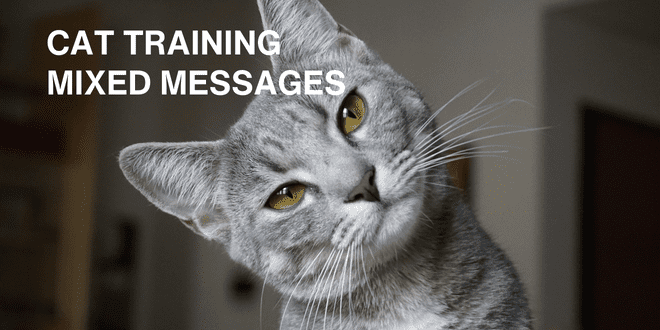
Surprisingly, you may be sending a mixed message to your cat when attempting to train or correct behavior issues. We’ve all done it at some point – we’ve unintentionally rewarded the cat for the very behavior we didn’t want displayed. How does this happen? It’s an easy and common mistake.
Communication Confusion and Your Cat
It’s very early in the morning. Your cat is meowing at you and walking up and down the bed hours before your alarm is set to go off. Kitty wants breakfast! In order to ensure you will get a few more hours of sleep, you get up and fill the cat’s bowl with food. You may have temporarily stopped the meowing but the message you sent to the cat was the non-stop vocalization resulted in a reward. Another example of a mixed message is when you don’t want the cat on the kitchen counter but you kiss and cuddle kitty as you pick him up and place him back down on the floor. The message the cat receives is that being on the counter results in some pretty desirable attention. Here’s another common example. The cat sits by the door and cries to go outside. The cat may even scratch at the door. You’ve yelled at him and maybe chased him away from the door a few times but he returns to the same spot and begins crying and scratching. Finally, you can’t take it anymore so you open the door and let the persistent cat outside just so you can have some peace and quiet. You’re teaching your cat that the very behavior you don’t like is what works so he’ll continue doing it to get those successful results again next time.
Set Your Cat up to Succeed
Cats are creatures of habit who like predictability and routine. You probably know when your cat is about to start meowing for food or pacing by the door to go outside. In the kitchen, you can predict the cat will show up just about the time you start preparing dinner. Use this knowledge to your advantage. Instead of rewarding kitty for unwanted behavior, change the plan. For example, for the cat who meows in the wee hours of the morning, do an interactive play session right before bed and then offer a treat or a late dinner to help reset his internal clock. In addition, set out a puzzle feeder or two at bedtime to keep your cat busy when the family is sleeping. A timer-controlled feeding station is another option. Cats are crepuscular and that means they’re most active at dusk and at dawn. So it makes sense for a cat to start getting hungry and active long before you’re ready to face the morning.
For the cat who sits by the door and meows to go outside, it’s time for some improvement on indoor environmental enrichment. Take a look around the indoors and see what can be added to create more activity and stimulation. This may include the addition of a cat tree, cat shelves, some puzzle feeders, cat tunnels, and more frequently scheduled interactive play sessions with family members. Make the indoors as interesting as the outdoors. Your cat is looking for stimulation, activity, and discovery. Those are all things you can supply in the safety of the indoor environment.
For the counter cruising cat, you need to figure out what the appeal of the elevated location is in order to address the problem. Is it that the cat wants the food up there? Or does he like looking out the kitchen window? If it’s a multicat household, does the cat feel safer up there? Or, is it an attention-getting behavior? Figure out the reason and then you can supply a better alternative. If it’s the elevation that’s desired, then set up a cat tree nearby or a window perch. If the cat is going up there for safety, create other elevated options and also work on the relationships between the cats to reduce tension. If it’s an attention-getting behavior, make sure you’re doing interactive play sessions a couple of times a day.
There’s Always a Reason for a Behavior
Don’t get frustrated and give in when it comes to unwanted behavior. Take the time to figure out what the motivation is and how you can supply what the cat needs in a way that’s acceptable to both of you.
Evaluate Your own Behavior Around Your Cat
As you go through the day with your cat, you probably send inconsistent messages without realizing it. If your cat is displaying a behavior you don’t want, pay attention to your own behavior and evaluate whether you’ve been sending mixed messages. Remember, reward and acknowledge the behavior you want to see again.
Don’t resort to punishment. When a cat is subjected to punishment by either being yelled at or physically disciplined, it often increases the level of fear and reactivity. Instead of the cat learning not to engage in the unwanted behavior, he starts associating the negative experience with the one administering the punishment.
Need More Information?
For more information on cat behavior and training, check out the best-selling books by Pam Johnson-Bennett. Pam’s books are available at bookstores and online. We’ve also included Amazon links here on our website.
If you have a question regarding your cat’s health, please contact your veterinarian. This article is not intended as a replacement for your cat’s veterinary care.

